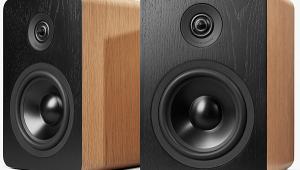Discovering the world of proxy servers has opened my eyes to the vast possibilities that lie beneath the surface of the internet. With proxy servers https://webhostinggeeks.com/blog/proxy-server-definition-functionality-t... , I've learned how to mask my IP address, enhance online security, and access geo-restricted content effortlessly. It's like stepping into a digital realm with unlimited potential, and I can't wait to share this newfound knowledge with others.
JBL 4329P Powered Studio Monitors Review

AT A GLANCE
Plus
Outstanding sound quality, dynamic abilities
Deep bass extension
Subwoofer output
Minus
No music-data or volume display
On the large side for stand-mount use
THE VERDICT
Big, powerful, flexible, dynamic, and all-around-excellent streaming loudspeakers.
How do you know when an audio trend is more than just a bandwagon? When America’s oldest hi-fi brand climbs on board. (Yes, I know that JBL and Klipsch were both founded in 1946. But JBL’s earliest incarnation goes back to the 1930’s.)
The trend I’m talking about is “just-press-play” speakers, stream-ready active speakers that embody everything you need for serious, high-resolution-audio listening except the music. Unpack, set up, log into your network, and be an instant audiophile. At least, that’s the theory behind such impressive examples as KEF’s LS60 and Klipsch’s The Nines. And now, JBL’s 4329P Studio Monitor system.
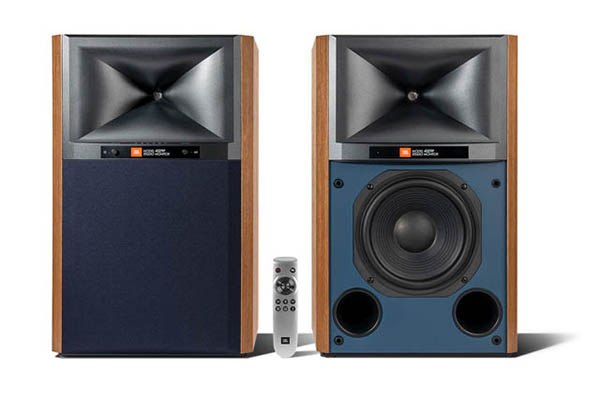
Unlike several competitors including the two mentioned above, JBL’s 4329P is strictly a Bring-Your-Own-Streaming solution: there’s no proprietary, streaming-quarterback app, such as KEF’s Connect or BluSound’s BluOS. Thus, whether you choose to stream via Wi-Fi (via either the Apple AirPlay or Chromecast protocols), Bluetooth, or wired-Ethernet, you’ll be responsible for your own connections and setup.
This is mostly a matter of convenience/organization, since the proprietary-streaming apps I’ve encountered simply aggregate your streaming services on a single page or two, using each’s wireless “casting” ability as usual, much as an aggregating app like Flipboard or Apple News combines news feeds.
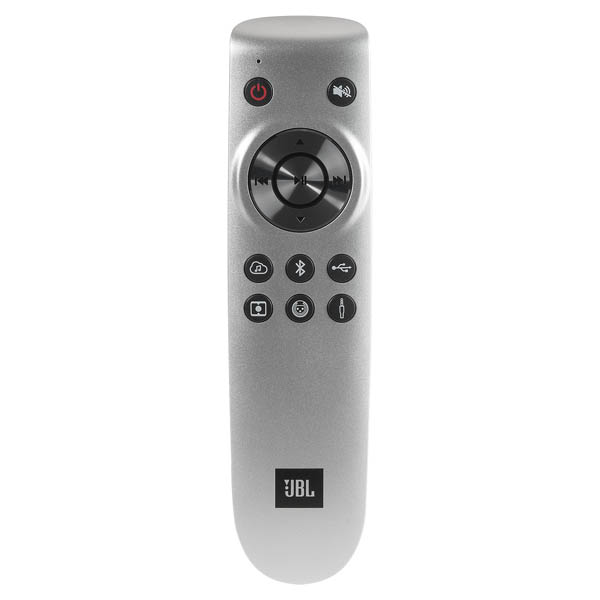
The 4329P—JBL’s naming system has been resolutely numeric since about forever—is a hefty powered two way: 8-inch woofer, and a patented horn-loaded 1-inch annular ring diaphragm (with phase plug) compression-driver tweeter. 300 watts of built-in amplification is apportioned 50/250w to tweeter and woofer. Visually, likely by design, the 4329P’s recall the classic JBL’s late-20th century studio monitors, from whom they’re surely descended: naked horn/tweeter, and a blue woofer-baffle board behind a dark fabric grille. It’s a no-nonsense mid-century-modern-ish look, and I liked it.
I left the woofer grilles off for full visual effect, as I expect most others would as well; the tweeters, deeply recessed in their rectangular horns where they should be safe from anything short of deliberate malice, are left naked by design.
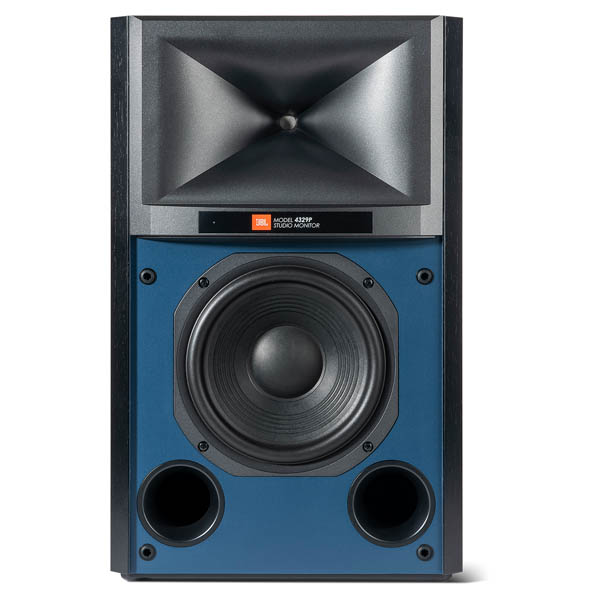
Around back each monitor reveals a small vertical heatsink serving the amps within. The main unit is flanked by a full complement of inputs and controls, while the secondary unit only has a Digital Link port in the form of a CAT5/6 Ethernet jack. Both also furnish IEC power-cable jacks, and master-power rockers.
Back to the main unit: besides the corresponding Link port, there’s a second Ethernet jack for wired network connection, and optical and USB-B digital inputs, balanced-line analog-stereo inputs (XLR), and a single unbalanced stereo line Aux input on 1/8th-inch mini-stereo jack. (surprisingly, there are no stereo unbalanced RCA inputs - a matter only of convenience, not function.) The only output is a single RCA Sub Out jack, which activates an 80 Hz hi-pass filter on the JBLs when connected.
Rear controls comprise a trio of mini-switches serving input sensitivity marked -10/+4 dB (presumably dBV, a pro-world reference), left/right assignment for the main unit for setup convenience, and bass contour (0/-3 dB), about which more will follow. Two tiny pushbuttons are labeled Reset, Service, and Sync, the last matched by an identical switch on the other speaker. JBL states that the 4329P, which are packaged (heavily!) in pairs, arrive pre-synched for wireless.
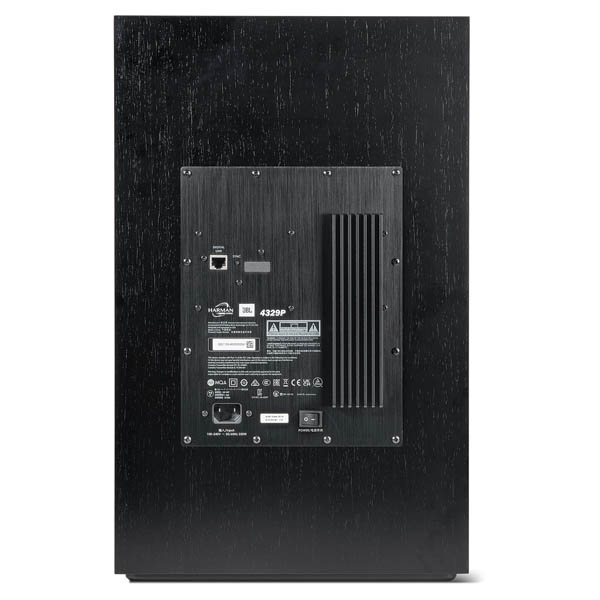
Setup & Listening
Hefting the JBLs (bend the knees!) onto a pair of adjustable stands at their lowest, 26-inch height set the 4329P’s tweeters just about even with my everyday 3-way stand-mount monitors, to which I planned to compare them. For permanent installations, JBL's optional JS-80 floor stands are designed to work with the 4329P as well as the L82 Classic.
In an entirely wireless setup (other than the power cords) the JBLs internal processing limit is 96 kHz/24-bit, which is well beyond any realistic threshold of audibility in my view. But wanting their full potential, after a brief unwired trial which worked fine, I connected the two units via the supplied CAT5/6 cable with which they were packed, which opens up resolution to 192/32.
Unfortunately, pinging the JBLs from Roon popped up the dreaded “…not yet certified” alert, so I had no way to stream fully hi-res content via my network, and thus resorted to wired-USB from a Mac laptop for a few hi-rez tracks.
The JBLs connected wirelessly via both Airplay and Chromecast out of the box despite never showing up on my iPhone’s Wi-Fi setup page. Wireless streaming up to these protocols’ inherent limits—16/48 and 24/96 respectively—was good to go; I used Chromecast via Roon for the bulk of my listening. (Roon-iacs will grok the difference between “Roon-Ready'' full-res wired streaming, which the 4329P’s aren’t quite yet and “Roon-Tested,” which exploits the two aforementioned wireless protocols, which they are.)
As I said, initially I went with no connections whatsoever, streaming wirelessly from Roon a few familiar tracks to get familiar with the JBLs. They impressed me mightily right off the hop, but recordings richly endowed with bass like James Taylor’s Hourglass could sound a little over-baked, at least with the speakers in my standard locations with about one meter spacing the front baffles from the wall behind them. For one instance, in the track “Jump Up Behind Me” there’s a unison between a low C at about 35 Hz in the extended (5-string?) electric bass and a very loose, deep drum of some sort, that sounded unnecessarily dominant and even a bit flabby.
Setting the main unit’s Bass Contour switch to the -3 dB position cleared this up nicely: much more than you’d guess a paltry 3 dB would effect. That’s room acoustics for you.
With the baseline setup finished, I started throwing tracks at the 4329P’s—more or less at random—and the JBLs fielded every one of them like Ozzie Smith. Suzanne Vega’s à cappella “Tom’s Diner” is an icon of speaker-evals for good reason: her bare alto voice, closely recorded on the brink of sibilance is a stern test for tweeter/woofer (or midrange) and crossover system. It's one the JBLs passed with ease: initial consonants never popped excessively, Vega’s prominent breath sounds remained raspy but naturally so, and the plosives of the last verse’s “Dit-dit-dit-dit…” stayed etched, but not poppy.
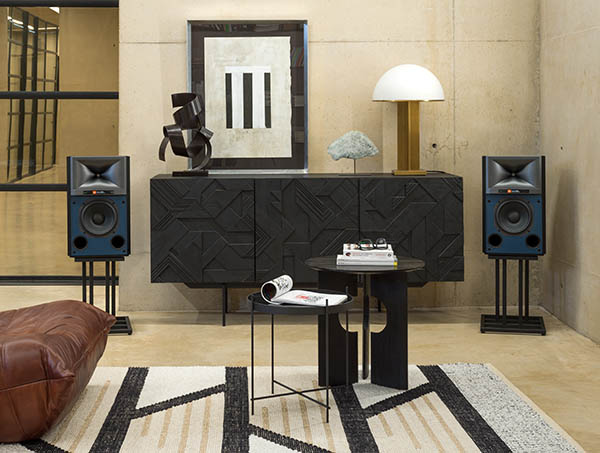
Another such is “Fast Car” from Tracy Chapman’s debut album. Here, Chapman’s fruity almost-tenor matched the tonal balance of my long-term monitors very nearly perfectly, something I’d not have expected from a horn-tweeter’d two-way a couple decades ago. The JBLs projected the heavily centered voice a foot or so more “out-front” in a very involving way, but otherwise these two superb designs were all but indistinguishable.
Does J.B.L. stand for “Jeez, bloody loud!”? Probably not (James B. Lansing, in fact), but it could do. The firm’s and Lansing’s predecessor designs for Altec have stood for clean high-level dynamics since they set the “talkie” movie-theater standard nearly 100 years ago, and the 4329P bears the banner with pride. “Jack of Speed” from Steely Dan’s Two Against Nature is one of the cleanest ultra-punchy recordings I know, and the JBLs were perfectly happy playing this at studio control-room monitoring levels, as these were understood back in the 70’s before we started thinking about hearing loss, and doing so with dramatic dynamics and punch.
In the interest of science I endured (enjoyed!) a verse or two at average levels well north of 90 dB SPL and thus peaks cresting 105 dB or so, and the 4329P’s displayed no loss of clarity, dynamism, or bottom-end heft, despite snare-drum strikes rifling across my studio like gunshots.
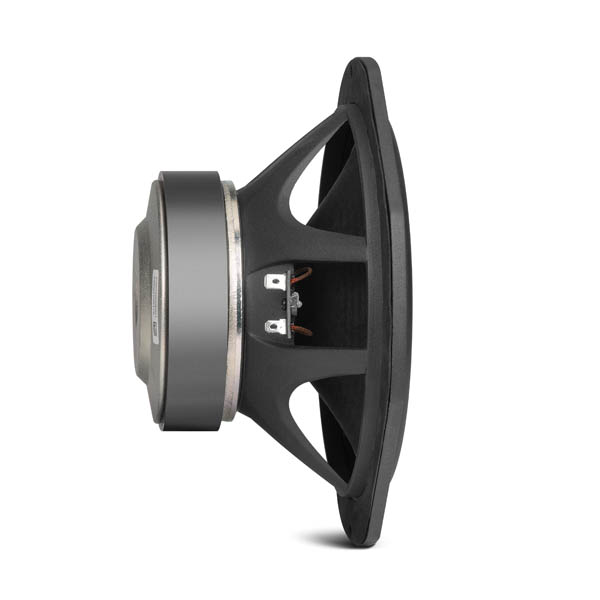
Usually, pushing digital-audio-managed powered speakers this far invokes a bit of bottom-octaves lightening, as “smart” bass compression kicks in to forestall amplifier clipping or driver damage, but if the JBLs were doing so I couldn’t discern it.
Belà Fleck’s “Flight of the Cosmic Hippo” is a favorite lower-octaves ref of mine, and the JBLs aced this, too. This humorous track’s down-sliding bass repeatedly plumbs well below 40 Hz, and the 4329P’s delivered nearly every Hz of it unattenuated, at least relative to my well-calibrated with-sub ref system, which has been proved very flat to around 18 Hz. The last quarter-second or so of each such note gave up a shade of ultra-low, fluttery sub-bass massiveness, but without direct comparison I’d never have known.
In the name of thoroughness I connected my compact but sub-20 Hz sub to the main 4329P’s Sub jack, and after confirming that this did indeed kick in an 80 Hz high-pass filter to the JBLs’ reproduction, re-listened to the track. There was more weight to the very lowest moments, and perceptibly more physical impact from deep-bass waves at very high volumes, but the difference was very far from dramatic. Unless you’re a confirmed bass-head or dub/techno or pipe-organ devotee, I’d wager the 4329P’s have enough bass, whoever you are.
Putting all these factors together is best judged via a truly well-recorded, naturally balanced full-orchestra recording of a really demanding piece. Shostakovich’s 13th symphony “Babi Yar”—really more of an oratorio, for bass, chorus, and large orchestra—qualifies in spades.
I streamed a live reading of this memorial to the Ukrainian victims of Nazi genocide by Muti and the Chicago Symphony and Chorus, which won a best-engineered Grammy a couple years ago, from Qobuz as a 96/24 FLAC. Via the JBLs this very naturalistic recording stunned me with the great definition of instruments and voices, letting the ear pick out individual voices from the (mostly) men’s choral parts, and the dense, dark woodwinds—the bass clarinet, for one example—of the dark, somber opening. The brasses were plangent and sparkling, the choral consonants crisp and, where appropriate, realistically sibilant, yet the Chicago’s warm and gooey string sound was well evident.
The 4329P’s didn’t sound to me as having much of a “house curve”—that is, a slight rolloff over the top three or four octaves—but they never sounded bright or pushy. Nevertheless, I tried dialing in a -2 dB curve, at 20 kHz starting at 2 kHz, via Roon’s DSP EQ facility, and preferred this flavoring slightly as promoting a more convincing, less highlighted sound of Chicago’s Orchestra Hall.
A bit surprisingly, the JBLs do not incorporate any equalization or treble trim functions (beyond the Bass Contour control already mentioned), though to be fair most modern sources, hardware and/or software, will provide something of this in some form. And again, I did not find the 4329P’s over-bright at in my fairly well diffracted studio, but had to wonder if a harder, more reflective room would answer quite as well.
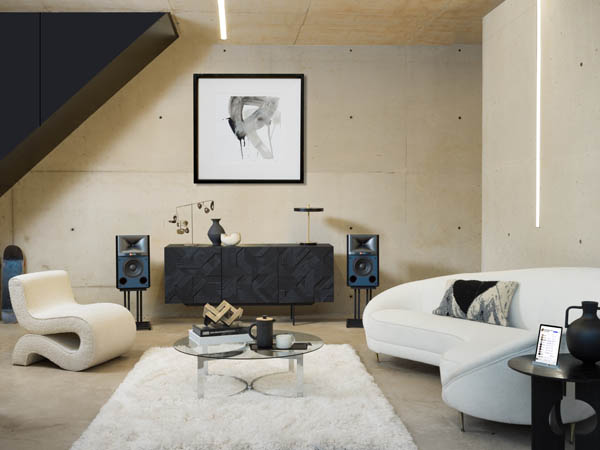
The JBLs did not conjure a super- wide or “spacey” stereo image, nor would I expect such from such a directivity-controlled design, but they did create a solid illusion of depth, with real gradations, in a virtual semi-circle extending mostly behind the speakers. It’s a trade-off common to many monitor-type designs, and a fair exchange, I felt, for the 4329P’s outstanding precision and definition.
The Hands-On Stuff
JBL supplies a small remote handset with the 4329P’s. This provides volume/mute, direct-access keys for each input/streaming/BT, volume/mute, and skip/search and play-pause for streaming sources that conform to AirPlay or Chromecast protocols—all three apps I tried (Qobuz, Tidal, and Roon) responded accordingly. On the front of the main unit are found one tiny turn/push knob for volume/mute, and another that steps through the inputs and activates Bluetooth pairing when pushed.
A tiny LED on each speaker indicates power, streaming, and pairing conditions, with another for network status, through various combinations of colors and flashings. One LED each resides above the 6 icons representing the inputs/streaming selections, but these are so small you’d have to be right on top of the speakers with a magnifying glass for them to prove useful.
And as far as user-interaction goes that’s about it. There’s no user-accessible DSP for EQ, placement-compensation, room-correction, or anything else. It’s an opportunity missed in my opinion—the DSP hardware is already on board—but doubtless JBL had their reasons. (One at least was likely to prevent users from screwing things up rather than improving them—always a risk with the power of DSP.) The JBLs feature the usual sleep-mode and auto-on routines, which makes this a truly just-press-play sound system, and a very fine one.
JBL’s largest and most capable streaming speaker to date is, from a purely audio perspective, an unreserved success. Even a triumph. The 4329P’s size, look, and ergonomics won’t be for everyone. Nor will its price; there are competitors for a third or so less that come close to equalling their abilities, but none that I know of betters them in all three of tonal accuracy, bass extension, and lifelike dynamics at realistic playback volumes. If you pass the above qualifications, they are a must-hear.
- Log in or register to post comments


The reviewers attention to detail particularly in assessing the bass response and the impact of the Bass Contour switch adds a practical dimension to the review making it a helpful guide for potential buyers.
Expert Massage Therapists in Honolulu HI
















